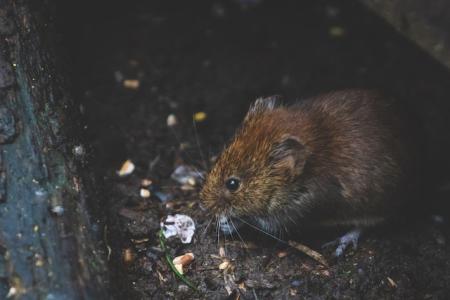About Voles
Voles are small, stocky rodents often confused with mice or moles, but they’re their own species with distinct habits. Sometimes called “meadow mice,” voles feed on grasses, roots, and bark rather than insects, and their tunneling can cause noticeable lawn and garden damage. Common types include meadow voles, prairie voles, and pine voles, each thriving in different habitats. While they play a role in the ecosystem as prey for larger animals, their fast-growing populations make them a common concern for homeowners.
What Do Voles Look Like?

Voles are small, chunky rodents with short legs, tiny eyes, and a blunt, rounded snout. Unlike mice, they have shorter tails and a stockier build, usually ranging from 3 to 7 inches long. Their fur is typically brown or gray, helping them blend into grassy or wooded areas.
Here are a few key features to look for:
- Stocky body, about 3 to 7 inches long.
- Short, stubby tail compared to a mouse.
- Small eyes and rounded snout.
- Fur that is usually brown or gray.
What Are The Unique Characteristics of Voles?
Voles are more than just small rodents — their behaviors and habits set them apart from similar animals like mice and moles. They thrive in grassy or wooded environments, where they create intricate networks of surface runways and burrows. Because they reproduce year-round and can have multiple litters with several pups at a time, vole populations can expand very quickly. Their diet is another defining trait: instead of eating insects like moles, voles feed almost entirely on plants, chewing through roots, bulbs, grasses, and even the bark of young trees.
Here are some key characteristics that make voles unique:
- Burrowing and runways: Voles build shallow tunnels and above-ground runways that leave visible tracks across lawns.
- Rapid reproduction: A single female can produce several litters per year, leading to sudden population booms.
- Plant-based diet: They feed on grasses, roots, bulbs, seeds, and tree bark, often causing damage to gardens and landscapes.
- Short lifespan, high activity: Although most voles live only a few months to a year, they are active year-round and do not hibernate.
- Important prey species: Voles play a role in the food chain as a key food source for hawks, owls, snakes, foxes, and other predators.
- Easily mistaken identity: Their mouse-like size and mole-like burrowing habits make them one of the most commonly misidentified yard pests.
What Do Voles Eat?
Voles are herbivores, which means their diet is made up almost entirely of plants. They chew on grasses, seeds, roots, bulbs, and garden plants, and they’re especially known for gnawing the bark off young trees and shrubs during colder months. Because they feed underground and at the surface, the damage often isn’t noticed until plants start to wilt, lawns thin out, or trees show signs of stress.
Here’s a breakdown of what voles eat:
- Grasses and leafy plants.
- Roots, seeds, and flower bulbs.
- Bark from trees and shrubs, especially in winter.
- Crops and garden plants like vegetables.
In your yard, this feeding habit can quickly lead to dead patches of grass, damaged landscaping, and even the loss of young trees. Left unchecked, a vole population can cause widespread damage in a short amount of time.
Where Are Voles Commonly Found?
Voles are drawn to areas that provide both food and cover. They prefer spots with thick vegetation, ground cover, or mulch that offers protection from predators. Lawns, gardens, and landscaped areas often provide the perfect mix of shelter and food, which is why homeowners tend to see vole activity close to their homes.
Here are some of the most common places voles are found:
- Lawns and grassy areas with dense turf.
- Gardens with vegetables, flowers, or bulbs.
- Mulch beds and thick groundcover near trees or shrubs.
- Orchards or yards with young trees (where they can chew bark).
- Fields, meadows, or areas with tall grasses.
Because they build shallow tunnels and runways, voles are often noticed by the trails they leave in the grass or the sudden damage to plants. If your yard has food sources and cover, it can easily attract voles.
What Are The Risks of a Vole Infestation?
Voles can quickly damage lawns, gardens, and young trees by chewing through roots, bulbs, and bark. Their tunneling leaves behind messy surface runways, and because they reproduce so quickly, a small issue can spread across a yard in no time.
If voles are damaging your yard or garden in the Boise area, Affinity Pest Control provides effective vole removal and prevention services to protect your outdoor spaces.